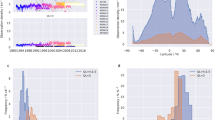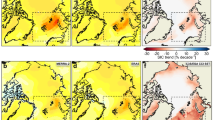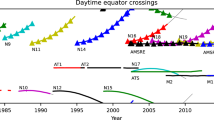Abstract
Existing estimates of sea surface temperatures (SSTs) indicate that, during the early twentieth century, the North Atlantic and northeast Pacific oceans warmed by twice the global average, whereas the northwest Pacific Ocean cooled by an amount equal to the global average1,2,3,4. Such a heterogeneous pattern suggests first-order contributions from regional variations in forcing or in ocean–atmosphere heat fluxes5,6. These older SST estimates are, however, derived from measurements of water temperatures in ship-board buckets, and must be corrected for substantial biases7,8,9. Here we show that correcting for offsets among groups of bucket measurements leads to SST variations that correlate better with nearby land temperatures and are more homogeneous in their pattern of warming. Offsets are identified by systematically comparing nearby SST observations among different groups10. Correcting for offsets in German measurements decreases warming rates in the North Atlantic, whereas correcting for Japanese measurement offsets leads to increased and more uniform warming in the North Pacific. Japanese measurement offsets in the 1930s primarily result from records having been truncated to whole degrees Celsius when the records were digitized in the 1960s. These findings underscore the fact that historical SST records reflect both physical and social dimensions in data collection, and suggest that further opportunities exist for improving the accuracy of historical SST records9,11.
This is a preview of subscription content, access via your institution
Access options
Access Nature and 54 other Nature Portfolio journals
Get Nature+, our best-value online-access subscription
$29.99 / 30 days
cancel any time
Subscribe to this journal
Receive 51 print issues and online access
$199.00 per year
only $3.90 per issue
Buy this article
- Purchase on Springer Link
- Instant access to full article PDF
Prices may be subject to local taxes which are calculated during checkout




Similar content being viewed by others
Data availability
All datasets used in this study are publicly available as follows: ICOADS3.0 (https://rda.ucar.edu/datasets/ds548.0/), HadSST3 and a 100-member ensemble (https://www.metoffice.gov.uk/hadobs/hadsst3/data/download.html), HadISST2 and a 10-member ensemble (https://www.metoffice.gov.uk/hadobs/hadisst/data/hadisst2/), COBESST2 (https://www.esrl.noaa.gov/psd/data/gridded/data.cobe2.html), ERSST5 (https://www.esrl.noaa.gov/psd/data/gridded/data.noaa.ersst.v5.html), CRUTEM4 (https://crudata.uea.ac.uk/cru/data/temperature/), ERA-Interim Reanalysis (https://www.ecmwf.int/en/forecasts/datasets/reanalysis-datasets/era-interim), NOAA 20th Century Reanalysis (https://www.esrl.noaa.gov/psd/data/20thC_Rean/), and NOCv2.0 surface flux (https://rda.ucar.edu/datasets/ds260.3/). ICOADSa and ICOADSb, together with archived versions of all other SST datasets used in this study, are posted at https://doi.org/10.7910/DVN/DXJIGA.
Code availability
Code allowing the full reproduction of our results is posted on Github at https://github.com/duochanatharvard/Homogeneous_early_20th_century_warming.
References
Huang, B. et al. Extended reconstructed sea surface temperature, version 5 (ERSSTv5): upgrades, validations, and intercomparisons. J. Clim. 30, 8179–8205 (2017).
Hirahara, S., Ishii, M. & Fukuda, Y. Centennial-scale sea surface temperature analysis and its uncertainty. J. Clim. 30, 57–75 (2014).
Kennedy, J., Rayner, N., Saunby, M. & Millington, S. Bringing together measurements of sea surface temperature made in situ with retrievals from satellite instruments to create a globally complete analysis for 1850 onwards, HadISST2. In EGU General Assembly Conference Abstracts Vol. 15 (2013).
Kennedy, J., Rayner, N., Smith, R., Parker, D. & Saunby, M. Reassessing biases and other uncertainties in sea surface temperature observations measured in situ since 1850: 2. Biases and homogenization. J. Geophys. Res. D 116, D14104 (2011).
Delworth, T. L. & Knutson, T. R. Simulation of early 20th century global warming. Science 287, 2246–2250 (2000).
Tung, K.-K. & Zhou, J. Using data to attribute episodes of warming and cooling in instrumental records. Proc. Natl Acad. Sci. USA 110, 2058–2063 (2013).
Folland, C. & Parker, D. Correction of instrumental biases in historical sea surface temperature data. Q. J. R. Meteorol. Soc. 121, 319–367 (1995).
Smith, T. M. & Reynolds, R. W. Bias corrections for historical sea surface temperatures based on marine air temperatures. J. Clim. 15, 73–87 (2002).
Kent, E. C. et al. A call for new approaches to quantifying biases in observations of sea surface temperature. Bull. Am. Meteorol. Soc. 98, 1601–1616 (2017).
Chan, D. & Huybers, P. Systematic differences in bucket sea surface temperature measurements amongst nations identified using a linear-mixed-effect method. J. Clim. 32, 2569–2589 (2019).
Davis, L. L., Thompson, D. W., Kennedy, J. J. & Kent, E. C. The importance of unresolved biases in 20th century sea-surface temperature observations. Bull. Am. Meteorol. Soc. 100, 621–629 (2018).
Tokinaga, H., Xie, S.-P. & Mukougawa, H. Early 20th-century Arctic warming intensified by Pacific and Atlantic multidecadal variability. Proc. Natl Acad. Sci. USA 114, 6227–6232 (2017).
Crook, J. A. & Forster, P. M. A balance between radiative forcing and climate feedback in the modeled 20th century temperature response. J. Geophys. Res. D 116, D17108 (2011).
Knutson, T. R., Zeng, F. & Wittenberg, A. T. Multimodel assessment of regional surface temperature trends: CMIP3 and CMIP5 twentieth-century simulations. J. Clim. 26, 8709–8743 (2013).
Stott, P. A. et al. External control of 20th century temperature by natural and anthropogenic forcings. Science 290, 2133–2137 (2000).
Myhre, G. et al. Anthropogenic and natural radiative forcing. Clim. Change 423, 658–740 (2013).
Schlesinger, M. E. & Ramankutty, N. An oscillation in the global climate system of period 65–70 years. Nature 367, 723–726 (1994).
Mantua, N. J., Hare, S. R., Zhang, Y., Wallace, J. M. & Francis, R. C. A Pacific interdecadal climate oscillation with impacts on salmon production. Bull. Am. Meteorol. Soc. 78, 1069–1079 (1997).
Karl, T. R. et al. Possible artifacts of data biases in the recent global surface warming hiatus. Science 348, 1469–1472 (2015).
Medhaug, I., Stolpe, M. B., Fischer, E. M. & Knutti, R. Reconciling controversies about the ‘global warming hiatus’. Nature 545, 41–47 (2017).
Thompson, D. W., Kennedy, J. J., Wallace, J. M. & Jones, P. D. A large discontinuity in the mid-twentieth century in observed global-mean surface temperature. Nature 453, 646–649 (2008).
Freeman, E. et al. ICOADS release 3.0: a major update to the historical marine climate record. Int. J. Climatol. 37, 2211–2232 (2017).
Bonferroni, C. Teoria statistica delle classi e calcolo delle probabilita. Pubbl. R Ist. Sup. Sci. Econ. Commer. Fir. 8, 3–62 (1936).
Rhines, A., Tingley, M. P., McKinnon, K. A. & Huybers, P. Decoding the precision of historical temperature observations. Q. J. R. Meteorol. Soc. 141, 2923–2933 (2015).
Wilkinson, C. et al. Recovery of logbooks and international marine data: the RECLAIM project. Int. J. Climatol. 31, 968–979 (2011).
Jones, P. et al. Hemispheric and large-scale land-surface air temperature variations: an extensive revision and an update to 2010. J. Geophys. Res. D 117, D05127 (2012).
Hegerl, G. C., Brönnimann, S., Schurer, A. & Cowan, T. The early 20th century warming: anomalies, causes, and consequences. Wiley Interdiscip. Rev. Clim. Change 9, e522 (2018).
Compo, G. P. et al. The twentieth century reanalysis project. Q. J. R. Meteorol. Soc. 137, 1–28 (2011).
Seager, R. et al. Would advance knowledge of 1930s SSTs have allowed prediction of the Dust Bowl drought? J. Clim. 21, 3261–3281 (2008).
Taylor, K. E., Stouffer, R. J. & Meehl, G. A. An overview of CMIP5 and the experiment design. Bull. Am. Meteorol. Soc. 93, 485–498 (2012).
Carella, G. et al. Estimating sea surface temperature measurement methods using characteristic differences in the diurnal cycle. Geophys. Res. Lett. 45, 363–371 (2018).
International Telecommunications Union Radio Regulations Appendix 2, 793–799 (ITU, 2016).
Carella, G., Kent, E. C. & Berry, D. I. A probabilistic approach to ship voyage reconstruction in ICOADS. Int. J. Climatol. 37, 2233–2247 (2017).
Berry, D. I. & Kent, E. C. A new air–sea interaction gridded dataset from ICOADS with uncertainty estimates. Bull. Am. Meteorol. Soc. 90, 645–656 (2009).
Dee, D. P. et al. The ERA-interim reanalysis: configuration and performance of the data assimilation system. Q. J. R. Meteorol. Soc. 137, 553–597 (2011).
Harville, D. A. Maximum likelihood approaches to variance component estimation and to related problems. J. Am. Stat. Assoc. 72, 320–338 (1977).
Kennedy, J., Rayner, N., Smith, R., Parker, D. & Saunby, M. Reassessing biases and other uncertainties in sea surface temperature observations measured in situ since 1850: 1. Measurement and sampling uncertainties. J. Geophys. Res. D 116, D14104 (2011).
Woodruff, S. D. et al. ICOADS release 2.5: extensions and enhancements to the surface marine meteorological archive. Int. J. Climatol. 31, 951–967 (2011).
Acknowledgements
D.C. and P.H. were funded by the Harvard Global Institute and US National Science Foundation (NSF) Award 1558939. E.C.K. and D.I.B. were funded by the UK Natural Environment Research Council (NERC) through grants NE/R015953/1 and NE/J020788/1. C. Wunsch (MIT, Harvard) and P.-W. Chan (Harvard) provided helpful feedback on an earlier draft.
Author information
Authors and Affiliations
Contributions
D.C. and P.H. conceived and designed the study; D.C. performed the analyses; and all authors contributed to interpreting results and writing the paper.
Corresponding author
Ethics declarations
Competing interests
The authors declare no competing interests.
Additional information
Publisher’s note: Springer Nature remains neutral with regard to jurisdictional claims in published maps and institutional affiliations.
Extended data figures and tables
Extended Data Fig. 1 1908–1941 SST trends in major observational estimates and CMIP5 simulations.
a–d, Maps of SST trends for: a, HadSST3 (ref. 4); b, HadISST2 (ref. 3); c, ERSST5 (ref. 1); and d, COBESST2 (ref. 2). Although different correction schemes were used to account for bucket biases in each observational estimate, panels a–d show similar early-twentieth-century trends. e, Averages from 88 CMIP5 historical experiment simulations30. Model results and observed trends are all regridded to a common 5°×5° resolution to facilitate intercomparison. f, Zonal variance in 1908–1941 SST trends. Shading indicates a range covering 80% of the 88 CMIP5 members, which come from 39 coupled climate models (see Supplementary Table 4). ICOADSb has a more uniform spatial pattern of early-twentieth-century warming than other SST estimates.
Extended Data Fig. 2 Groupwise decomposition of SST corrections in ICOADSb.
a, b, Contributions from individual groups over the North Pacific Ocean (NP; a) and the North Atlantic Ocean (NA; b). c, SST offsets for groups having major influences on 1908–1941 trend estimates. Groupwise corrections relate foremost to a growing cold bias amongst Japanese deck 118 (yellow) in the Pacific, a pre-World War I cold bias in deck 156 (grey), and a growing warm bias in German deck 192 (blue) in the Atlantic. Shading indicates 2 s.d. uncertainties, and the sizes of the markers indicate numbers of SST observations. d, As for c, but for an analysis in which the Japanese Kobe collection is divided into decks 762, 118 and 119. (Deck 119 is not shown because it spans only 1951 to 1961.) In this analysis, the mean offset over the North Pacific is 0.07 ± 0.14 °C (2 s.d.) for deck 762 from 1908 to 1930, and −0.24 ± 0.16 °C for deck 118 from 1935 onward, consistent with the case when decks are not separated (c). In addition, the cold offset of the Japanese Kobe Collection and the warm offset of German deck 192 are robust even if SSTs from the two groups are not allowed to be directly paired in the intercomparison.
Extended Data Fig. 3 Decimal distributions of SSTs.
a, Deck 762 from the Japanese Kobe Collection. The near-absence of a 0.5 °C decimal is indicative of data being recorded in whole-degrees Fahrenheit and then converted into tenths-of-a-degree Celsius. The blue line shows the percentage of SSTs recorded in whole degrees. b, Temperatures reported in deck 118 of the Japanese Kobe Collection are all truncated to whole-degrees Celsius and constitute more than 99% of the Kobe Collection measurements between 1933 and 1941. c, German deck 192 is a time-varying mix of data in whole-degrees Celsius and data in tenths-of-a-degree Celsius; most common in the latter are values of 0 and 5, and then even digits. The percentage of SSTs archived in whole-degrees Celsius increases from 29% in 1908 to 50% in 1941 (blue line). d, Image from the reference manual of Japanese Kobe Collection deck 118 (ref. 25), where the red box highlights that temperature measurements were digitized at whole-degrees Celsius and all decimals dropped (https://icoads.noaa.gov/reclaim/pdf/dck118.pdf).
Extended Data Fig. 4 Sensitivity of 1908–1941 SST trends.
As for Fig. 3, but with Japanese Kobe Collection decks 118, 119 and 762 separated into distinct groups. a, SST trends in ICOADSa; b, trends associated with the corrections for groupwise offsets; c, SST trends in ICOADSb after applying groupwise corrections.
Extended Data Fig. 5 Comparison of SSTs with coastal air temperature estimates.
a, b, Air temperatures are from CRUTEM4 (ref. 26) near the east coast of Asia (a) and the east coast of the US (b). These two regions are indicated by the shading in c and host the largest groupwise corrections. SSTs corrected for groupwise offsets (ICOADSb, blue line) correlate better with CRUTEM4 air temperatures (black line) than do SSTs having only common bucket-bias corrections (ICOADSa, grey line), especially for Asia in the 1930s. See Table 1 for correlations associated with other major SST estimates.
Extended Data Fig. 6 Sea level pressure and the Pacific Decadal Oscillation.
a, Spatial pattern of sea level pressure (SLP) associated with a 1σ increase in the PDO index18. b, 1908–1941 SLP trends from the NOAA’s 20th Century Reanalysis28. c–g, Regressions of SST-PDO indices against the SLP-PDO index for ICOADSb (c), ERSST5 (d), COBESST2 (e), HadISST2 (f) and HadSST3 (g). The SLP-PDO index is computed from the NOAA’s 20th Century Reanalysis, and the regression analysis is performed for 1908–1941 (red) and 1948–2010 (black). h, Regression coefficients for each dataset over 1908–1941 (red) and 1948–2010 (black). Note that the y axis starts from 0.25 °C mb−1. Error bars indicate 2 s.d. uncertainties. ICOADSb has a similar regression coefficient over 1908–1941 to that found using other SST datasets and other epochs.
Extended Data Fig. 7 1σ uncertainty estimates of 1908–1941 trends.
a, Sampling and observational uncertainty inherent to all SST estimates, estimated using 1,000 members drawn from normal distributions that have a mean of zero, and a variance of the sampling and observational uncertainty equal to that specified in ref. 37. b, Uncertainties associated with common bucket-bias corrections in HadSST3, which takes into account shifts between wooden and canvas buckets, exposure time, and ship speed, obtained from a 100-member ensemble4. c, Uncertainty of groupwise corrections in ICOADSb, estimated from 1,000 random correction members. d, Uncertainties quadratically combining those shown in a–c. Note that these uncertainties are for individual grid boxes, whereas Table 1 reports uncertainties for regional or global averages.
Extended Data Fig. 8 Common bucket-bias corrections.
a, Comparison of annual global mean common bucket-bias corrections reproduced in ICOADSa and from HadSST3 for 1850–1941. b, As in a, but for monthly mean corrections from 1920 to 1929. Bucket corrections in ICOADSa are subsampled over HadSST3 grids before computing global means. c–f, Comparisons of spatial patterns of SST corrections for the period 1920 to 1930. Shown are our corrections for December, January and February (c) and June, July and August (e); and the HadSST3 corrections for December, January and February (d) and June, July and August (f). The 1920–1930 period is assumed to contain only canvas buckets, and an average of 78% of SSTs from fast ships (7 m s−1) and 22% from slow ships (4 m s−1). g–j, As for c–f, but for corrections over 1850 to 1860—a period assumed to contain only slow ships (4 m s−1), with 36% of SST measurements from canvas buckets and 64% from wooden buckets. Discrepancies become apparent from the 1930s because of increasing contributions from warm-biased engine-room-intake measurements in HadSST3, whereas we focus only on bucket measurements.
Extended Data Fig. 9 Groups providing bucket SST measurements from 1850 to 2014.
Left-hand y-axis: numbers of bucket SST measurements from individual groups, identified by country and deck information as colour coded, in ICOADS3.0. CA, Canada; BR, Brazil; DE, Germany; FR, France; GB, Great Britain; NL, Netherlands; JP, Japan; RU, Russia; US, United States; —, missing country information. Black text shows the 46 of 162 groups that contributed to the SST archive between 1908 and 1941, which is indicated by shading. Groups with fewer than 2 × 105 measurements throughout 1850 to 2014 are labelled as ‘other groups’. Right-hand y-axis, percentage of measurements that are from buckets (black line). Bucket measurements constitute nearly all observations before the 1930s.
Extended Data Fig. 10 Partitioning of random and systematic errors.
Updating the methodology for identifying nationality allows more groups of SSTs to be compared, and leads to minor changes in estimated random and systematic errors. Shown are fits according to equation (6) in ref. 10, depending on random measurement error (\({\sigma }_{{\rm{rnd}}}^{2}\)), systematic ship-level error (\({\sigma }_{{\rm{shp}}}^{2}\)), and the scaling relationship between the number of measurements and ships (x). Fits are performed using logarithms, and shading indicates 2 s.d. in logarithmic space.
Supplementary information
Supplementary Information
The Supplementary Information contains four tables: Table 1 lists groupings of SST observations, Table 2 gives the sensitivity of SST trend estimates associated with modifying starting and ending years, Table 3 gives parameters for a bucket model, and Table 4 lists CMIP5 climate model ensemble members.
Rights and permissions
About this article
Cite this article
Chan, D., Kent, E.C., Berry, D.I. et al. Correcting datasets leads to more homogeneous early-twentieth-century sea surface warming. Nature 571, 393–397 (2019). https://doi.org/10.1038/s41586-019-1349-2
Received:
Accepted:
Published:
Issue Date:
DOI: https://doi.org/10.1038/s41586-019-1349-2
This article is cited by
-
The scorching temperatures shock effect on firms’ performance: a global perspective
Review of Quantitative Finance and Accounting (2024)
-
Transcriptomic Response of the Atlantic Surfclam (Spisula solidissima) to Acute Heat Stress
Marine Biotechnology (2024)
-
Satellite-observed strong subtropical ocean warming as an early signature of global warming
Communications Earth & Environment (2023)
-
Tropical Atlantic multidecadal variability is dominated by external forcing
Nature (2023)
-
Drivers of low-frequency Sahel precipitation variability: comparing CMIP5 and CMIP6 ensemble means with observations
Climate Dynamics (2023)
Comments
By submitting a comment you agree to abide by our Terms and Community Guidelines. If you find something abusive or that does not comply with our terms or guidelines please flag it as inappropriate.



